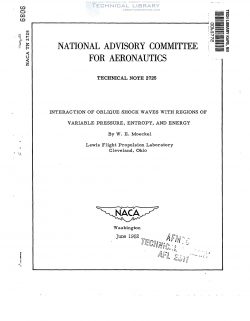naca-tn-2725
- Version
- 104 Downloads
- 1.33 MB File Size
- 1 File Count
- December 16, 2016 Create Date
- December 16, 2016 Last Updated
National Advisory Committee for Aeronautics, Technical Notes - Interaction of Oblique Shock Waves with Regions of Variable Pressure, Entropy, and Energy

Equations are derived for computing the form of an oblique shock
wave as it passes through supersonic regions in which static pressure,
stagnation pressure, stagnation temperature, or combinations of these
are continuously variable. Rigorous portions of the analysis are limited
to shock strengths for which the flow downstream of the shock remains
supersonic. _ When no downstream waves other than those generated by
the interaction process are present, the rate of change of shock angle'
with upstream Mach number is found to be a function only of the local
shock angle and upstream Mach number; hence, the propagation through
a nonuniform region depends only on the initial shock strength and Mach
number. A procedure is described for computing the supersonic portion
of the flow field downstream of the shock wave.
For the special cases of supersonic shear flow and Prandtl-Meyer
flow, charts of the shock angle as a function of upstream Mach number
are presented so that the passage of a shock wave through these types
of nonuniform regions can be easily traced. For a prescribed initial
shock strength and initial mach number, a minimum upstream Mach number
is found below which no physically realistic solution can be obtained
with the equations for simple propagation. This result serves as a
sufficient condition for the avoidance of separated‘flow, reversed
flow, or other upstream effects. An example is computed of the propaga—
tion of a shock wave through a wake-type supersonic shear profile and
the flow field downstream of the shock is constructed.
The most frequently discussed example of the propagation of a
shock wave into a nonuniform flow region appears, at present, to be
the shockrwave boundary—layer interaction.problem. Although much
theoretical and experimental research has been devoted to this problem,
it is still unsolved in the sense that no method exists whereby the
effect of a shock of prescribed strength on a boundary layer with
prescribed profile can be predicted. The difficulty in formulating a
theoretical approach can be attributed chiefly to the fact that the
flow upstream of the shock is not independent of the presence of the
shock. If the subsonic portion.of the boundary layer were removed
(by continuous suction, for example), it might be expected that this
difficulty would'be eliminated. Circumstances frequently arise, hows
ever, for which even this expectation is not fulfilled. It was shown
qualitatively in reference 1, for example, that the presence of a
supersonic wake upstream of a blunt body requires modification of the
upstream flow in order that physically realistic pressure gradients
can be obtained downstream of the detached shock. The fact that the
flow upstream of the shock'is completely supersonic does not, therefore,
guarantee that the upstream flow will be uninfluenced.by the presence
of the shock.
| File | Action |
|---|---|
| naca-tn-2725 Interaction of Oblique Shock Waves with Regions of Variable Pressure, Entropy, and Energy.pdf | Download |

Comment On This Post